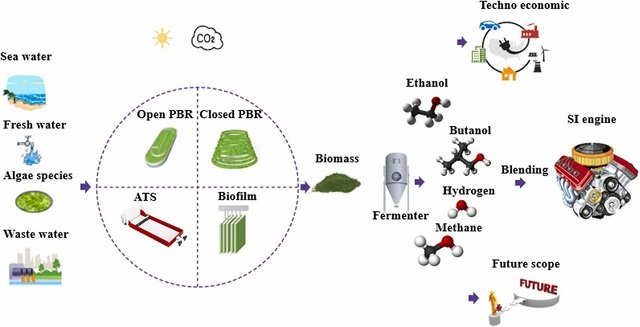
Shrimp farming poses a significant environmental challenge: the generation of wastewater. These wastewater streams are laden with organic and inorganic pollutants, threatening the health of our waterways. However, scientists are exploring a promising solution harnessing the power of nature: indigenous algae and bacteria.
A recent study published by scientists from Purdue University (USA) and Suez University (Egypt) investigated the effectiveness of a natural treatment system utilizing a combination of microalgae, cyanobacteria, and indigenous bacteria found in shrimp wastewater. The research team tested cultures of different algae (Chlorococcum minutus, Porphyridum cruentum, Chlorella vulgaris, and Chlorella reinhardtii) alongside the natural bacterial community (Microcystis aeruginosa and Fishcherella muscicola).
Harnessing the power of nature’s small teams
Shrimp waste and unconsumed feed accumulate in the cultivation ponds, releasing harmful ammonia, nitrogen, and phosphorus. These pollutants can deplete oxygen, disrupt ecosystems, and even lead to the death of aquatic animals.
In summary, the discharge of untreated wastewater can cause:
- Oxygen depletion: Harmful to aquatic life.
- Harmful algal blooms: Suffocating other marine organisms.
- Biodiversity reduction: Disturbance of delicate ecosystem balance.
Traditional treatment methods: a double-edged sword
Conventional methods, such as chemical treatment, may remove pollutants but often come with high costs and can leave behind harmful residues. Artificial wetlands offer a more natural approach but require ample space and struggle against certain contaminants.
A promising solution: the power of partnerships
The study investigated the effectiveness of using microalgae and indigenous bacteria working together to treat shrimp wastewater. These tiny organisms form a symbiotic relationship.
Algae and bacteria work in beautiful synergy:
- Algae provide oxygen and carbon dioxide for bacteria.
- Bacteria release essential nutrients for algae growth.
This symbiotic relationship creates a powerful wastewater treatment system.
Stay Always Informed
Join our communities to instantly receive the most important news, reports, and analysis from the aquaculture industry.
Getting rid of the bad stuff
The study explored the effectiveness of combining different microalgae and cyanobacteria cultures (including familiar names like Chlorella vulgaris and Microcystis aeruginosa) with natural bacteria present in shrimp wastewater. These microscopic powerhouses worked together to significantly reduce pollutants in just 21 days!
- Reduced organic matter: The study observed a remarkable 95% removal of soluble chemical oxygen demand (sCOD), indicating a significant decrease in organic pollutants, thanks to Fishcherella muscicola.
- Nitrogen removal champions: Several microalgae and cyanobacteria, including C. vulgaris, M. aeruginosa, and C. reinhardtii, excelled in degrading total dissolved nitrogen by over 90%. Additionally, C. vulgaris stood out with an impressive 93% removal of dissolved organic nitrogen.
- Phosphate prowess: All algae and bacteria associations achieved a remarkable feat: over 99% removal of phosphate from wastewater. This is vital for preventing eutrophication, a condition where excess nutrients fuel the growth of unwanted algae.
Accelerating cleanup
The researchers also calculated degradation kinetics, revealing fascinating information:
- M. aeruginosa facilitated the fastest breakdown of sCOD, with a half-life (t1/2) of only 5 days.
- F. muscicola and C. reinhardtii teamed up for the fastest removal of ammonia nitrogen (NH3-N) and phosphate, achieving a t1/2 of only 2.9 days for both.
Symbiosis for sustainability
These findings highlight the power of a symbiotic relationship between algae and bacteria. Together, they effectively clean wastewater in a short incubation period (21 days). This natural treatment method offers a sustainable and eco-friendly alternative to conventional wastewater treatment processes.
Conclusion
“Shrimp wastewater treatment using pure cultures of indigenous algae and bacteria has shown great potential for effectively removing pollutants,” conclude the researchers.
This research paves the way for a more sustainable shrimp farming industry. By utilizing readily available indigenous algae and bacteria, shrimp farms can effectively treat their wastewater, minimizing their environmental footprint. This innovative approach promotes resource recovery within the aquaculture sector, offering benefits for both the environment and the shrimp industry.
The study was funded by the USDA National Institute of Food and Agriculture.
Contact
Halis Simsek
Department of Agricultural & Biological Engineering, Purdue University, W. Lafayette, IN, USA
Email: simsek@purdue.edu
Reference
Bhatt, P., Brown, P. B., Huang, J., Hussain, A. S., Liu, H. T., & Simsek, H. (2024). Algae and indigenous bacteria consortium in treatment of shrimp wastewater: A study for resource recovery in sustainable aquaculture system. Environmental Research, 250, 118447. https://doi.org/10.1016/j.envres.2024.118447
Editor at the digital magazine AquaHoy. He holds a degree in Aquaculture Biology from the National University of Santa (UNS) and a Master’s degree in Science and Innovation Management from the Polytechnic University of Valencia, with postgraduate diplomas in Business Innovation and Innovation Management. He possesses extensive experience in the aquaculture and fisheries sector, having led the Fisheries Innovation Unit of the National Program for Innovation in Fisheries and Aquaculture (PNIPA). He has served as a senior consultant in technology watch, an innovation project formulator and advisor, and a lecturer at UNS. He is a member of the Peruvian College of Biologists and was recognized by the World Aquaculture Society (WAS) in 2016 for his contribution to aquaculture.




